The Great Wall of China, Beijing

The Sunset of Great Wall
The Great Wall is an unparalleled travel adventure for many globetrotters and history enthusiasts, a journey that’s truly a once-in-a-lifetime opportunity.
Historically, the Great Wall of China stood as a formidable military barrier, spanning over 13,000 miles. It comprises several renowned sections, such as Badaling, Mutianyu, and Jinshanling, each with its unique allure, from stunning natural vistas to intact walls and watchtowers.
The most picturesque times to trek the Wall are during spring (April to June) and autumn (September to November), when the landscape is adorned with blooming trees and flowers, and the mountains are ablaze with color, all set against the pleasant weather. To sidestep the throngs of tourists, consider the less trafficked paths of Mutianyu or Jiankou, which offer more serene landscapes and gentler terrain. In April and September, the Badaling section is somewhat more tranquil, offering a comprehensive view of the meticulously maintained Ming-era bricks and watchtowers set against a breathtaking backdrop for history buffs.
Accessing most sections of the Great Wall from central Beijing typically requires 1 to 2.5 hours. For a typical visit, one to two days suffices to explore the key attractions of each section, and for those seeking a unique experience, an overnight camp can provide a rare glimpse of the Great Wall under the stars.
Recommended Tour Itinerary
Yangshuo & Li River, Guilin

The Li River
Yangshuo, a charming rural escape on the western banks of the Li River, boasts breathtaking karst topography and a serene, pastoral ambiance. It is situated 65 kilometers south of Guilin City and is accessible via a 70-minute bus ride.
Combining a visit to Yangshuo with a trip down the Li River is a perfect match. A cruise from Guilin to Yangshuo allows you to fully experience the river’s tranquil charm.
Prepare to be amazed by the iconic karst mountains of Guilin, the crystal-clear waters, and the legendary Nine-Horse Fresco. Exploring Yangshuo by bike or scooter is one of the best ways to delve into its captivating countryside and daily life, which includes rice paddies, local markets, cormorant fishing, and the agricultural routines of farmers and their buffaloes.
The spring and autumn seasons are ideal for visiting Yangshuo, with spring offering a misty backdrop to the Li River’s scenery and autumn providing a cool climate for cycling through the countryside and golden rice terraces. Spending 3-5 days in Yangshuo allows ample time to immerse in the local rural delights.
Recommended Tour Itinerary
Avatar Mountains, Zhangjiajie

The Avatar Mountains of Zhangjiajie
In Hunan Province, the Avatar Mountains of Zhangjiajie are renowned for their majestic pillars and mystical mists, making it a haven for adventure seekers and nature enthusiasts.
A one-hour drive from downtown Zhangjiajie leads you to Zhangjiajie National Forest Park, home to the Avatar Mountains. These mountains served as the inspiration for the floating landscapes in the Hollywood blockbuster “Avatar,” offering a must-see experience for fans of the film.
Visitors can reach a viewing platform near the Hallelujah Mountain for an impressive view of the “Southern Sky Column,” a towering 3544-foot pillar, and the surrounding vertical formations adorned with lush greenery.
The optimal months for visiting Zhangjiajie’s Avatar Mountains are April and October, when the scenery is at its most colorful with blossoms and falling leaves. A day trip is usually sufficient for capturing the floating mountains’ beauty. If you wish to explore the nearby Tianmen Mountain’s Heaven’s Gate, additional time is recommended.
Recommended Tour Itinerary
Mount Huangshan

The Mount Huangshan
Mount Huangshan, located in southern Anhui Province, is a marvel with its grand granite peaks, dramatic rock formations, enveloping mists, and distinctively shaped pines, which have long captivated poets, painters, and photographers.
A 35-minute drive from Huangshan City (approximately 50 km) takes you to the scenic area, a paradise for hikers and nature enthusiasts,One must-see is the Greeting Guest Pine, which extends like an arm welcoming visitors. Hiking to the peak offers the chance to capture the soaring, peculiarly shaped rocks and the enchanting sea of clouds.
The best times to visit Huangshan are spring and autumn, when azalea flowers bloom and red leaves paint the skies. A two-day tour is recommended to witness the awe-inspiring sunrise and the sea of clouds.
Recommended Tour Itinerary
Lijiang, Yunnan

The Lijiang Town
In Yunnan Province’s northwest, Lijiang is an ancient town with stunning natural beauty, including snow-capped mountains, intriguing canyons, and highland glacial lakes. It is a sought-after destination for hikers and city dwellers seeking respite.
Wandering the cobbled streets of Lijiang’s Old Town and Shuhe Ancient Town, you can experience the authentic ethnic customs and lifestyles of the Naxi, Bai, Tibetan, and Han people. The antique ambiance complements the natural splendor, such as the panoramic views of Jade Dragon Snow Mountain from the cable car.
For thrill-seekers, there are exclusive hikes through bushes and streams offering more extraordinary vistas. Tiger Leaping Gorge, with its varied and characteristic trails, presents distinct charms.
From late March to May, the mild and sunny weather is perfect for exploring Lijiang’s old towns and enjoying the city’s azalea blooms. Winter transforms Jade Dragon Snow Mountain and the three sections of Tiger Leaping Gorge into a wilder, yet imposing landscape.
Recommended Tour Itinerary
Shangri-la, Yunnan

The Snow Mountain
Shangri-La, in the Yunnan-Tibetan Region, is an unspoiled haven of rustic beauty and cultural heritage. Snow-capped mountains, alpine meadows, wild gorges, and Tibetan villages and monasteries all contribute to Shangri-La’s unique appeal.
You can admire the sacred snowy vistas of Meili and Baima Snow Mountains and explore Pudacuo National Park, home to a diverse array of wildlife.
Visiting local villages and temples, such as Nixi Pottery Village, Dukezong Old Town, and Songzanlin Lamasery (referred to as the Little Potala Palace),offers a glimpse into traditional Tibetan life and spirituality.
The best times to visit Shangri-La are April and May, when flowers are in full bloom, and the autumn season, which provides clearer views of Meili Snow Mountain and plateau lakes against a stunning blue sky.
Most visitors spend 2-3 days exploring Shangri-La’s main attractions, while 5-7 days allow for a deeper exploration of the wider region.
Recommended Tour Itinerary
Lhasa, Tibet
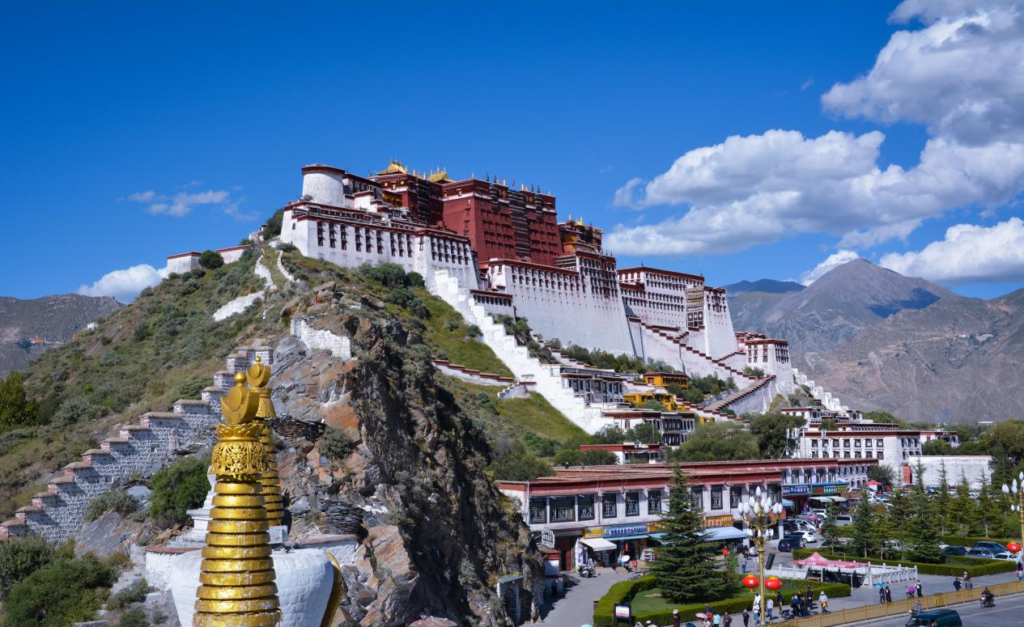
The Potala Palace
Lhasa, located in the embrace of the Himalayas, is the capital city of Tibet Autonomous Region. It is regarded as an important pilgrimage place for Tibetan Buddhists. This holy city attracts numerous culture enthusiasts to embark on a rewarding spiritual journey through its sacred Tibetan culture.
Lhasa is resplendent and boasts a large number of Buddhist architectures. In the iconic Potala Palace, you can explore the former glory of Tibetan kings and the Dalai Lamas. Here, you will see a repository of religious relics and thousands of Thangka paintings. The next stop, Jokhang Temple, offers an opportunity to experience Tibetan Buddhism among devout pilgrims, wafting incense, and flickering butter lamps.
Surrounding the temple is Barkhor Street, lined with shops and tea houses, allowing pedestrians to fully experience the essence of traditional Tibetan life in Lhasa. There are also many Buddhist monasteries and temples, such as Sera Monastery and Drepung Monastery, worth visiting.
The best time to visit Lhasa is from June to October. During this period, the days are warm and sunny, bringing clear sapphire-like skies. A classic Lhasa trip can be arranged within four days. The first two days can be spent visiting popular cultural sites in the city center, and the next two days can be used to enjoy the lake view at its border.
Recommended Tour Itinerary
Zhangye Danxia Geopark
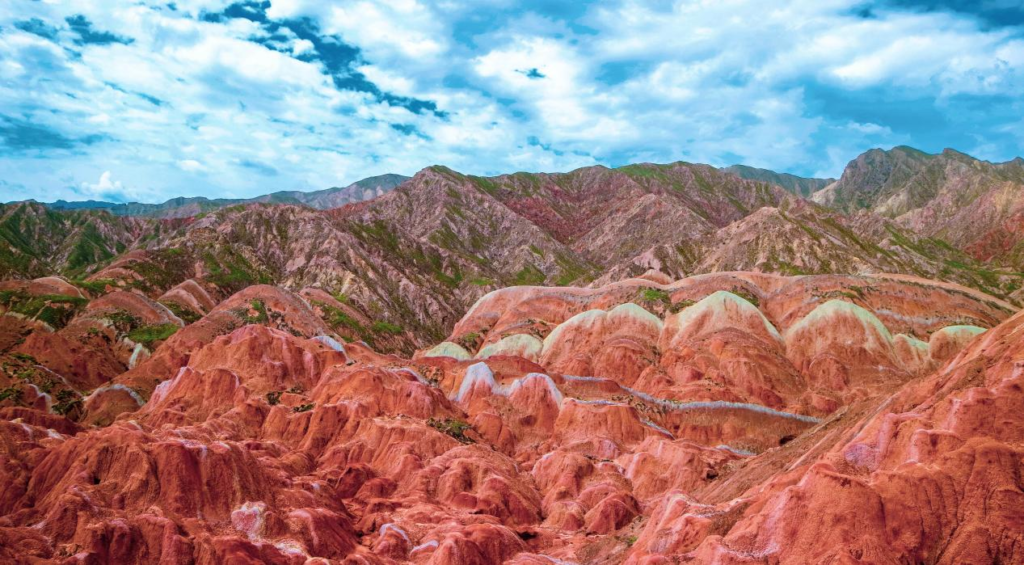
The Danxia Landform
Zhangye Danxia Geopark, nestled in the northwestern region of Gansu Province with the northern border touching Inner Mongolia, is renowned for its striking Danxia topography—characterized by the distinctive red, steep cliffs typical of northwest China—and its multi-hued, rainbow-like mountain ranges. It typically requires a 60-minute journey from the heart of Zhangye city to reach this national treasure.
The peak season for experiencing the park’s most radiant rainbow hues, thanks to optimal sunlight reflection, spans from July to September. We suggest allocating three days for your exploration of the park, allowing ample time to soak in its breathtaking scenery and delve into its fascinating cultural offerings.
Recommended Tour Itinerary
Kanas, Xinjiang

The Kanas Lake
Kanas, a lake that rivals the beauty of any masterpiece, is nestled within the lush forests and mountainous terrain of Altay in Northern Xinjiang. Enhanced accessibility has made it simpler for nature enthusiasts to discover the enchanting landscapes of this fairy-tale realm. A flight from Urumqi to Kanas Airport takes approximately 1.5 hours, followed by a scenic one-hour drive to the attraction.
The lake’s most captivating feature is the mesmerizing transformation of its colors throughout the seasons and varying environmental conditions. Visitors can observe the water shifting from a pristine crystal blue to an emerald green, and even to a deep, moody grey, each hue perfectly complementing the lake for a stunning visual feast.
Near Kanas Lake, you can visit Hemu and Baihaba villages, home to the Tuvan people, a branch of the Mongolian ethnic group. It’s a must to experience their traditional wooden dwellings, immerse in the Mongolian customs of Lamaism, and partake in the Tuvan way of life, which has been centered around herding for centuries.
For those who prefer milder temperatures, the best time to visit Kanas is from May to September. During this period, you can witness the ethereal golden hues of the birch forests surrounding the sparkling blue river and lake.
A two-day trip is sufficient to explore the scenic beauty of Kanas Lake and the nearby ancient villages. However, if you’re interested in historical sites, it’s recommended to extend your stay in Kanas City for a deeper dive into its rich past.
Recommended Tour Itinerary
The Bund, Shanghai
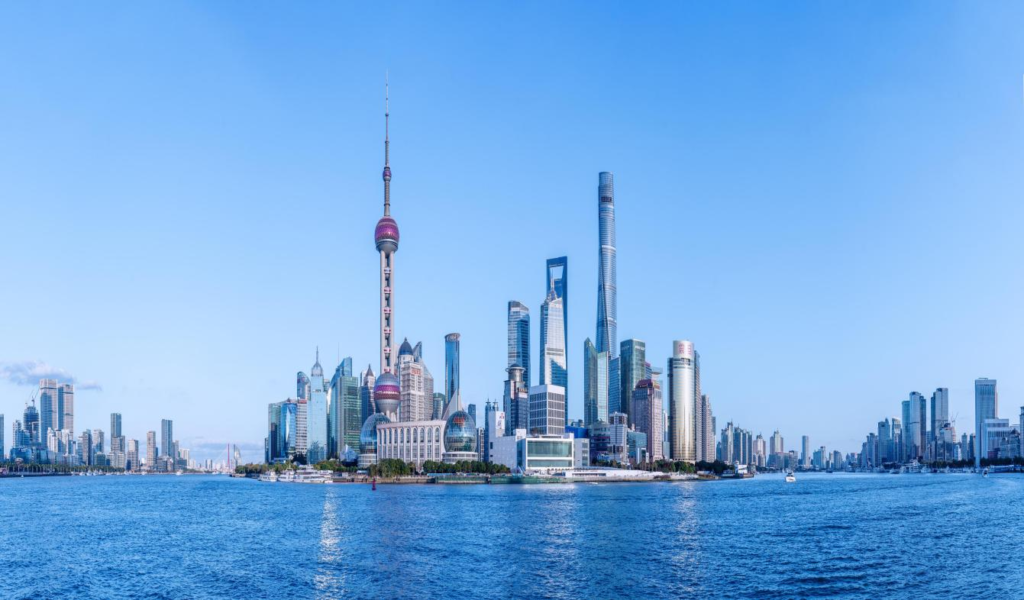
The Bund
The Bund, a landmark riverside destination and a preserved historical zone, sits on the western bank of the Huangpu River in Shanghai. It has evolved into an essential destination, showcasing a vibrant fusion of modernity with a rich tapestry of Chinese and Western heritage that spans centuries.
As you walk along the riverside promenade, you’re greeted by the architectural splendor of 26 edifices from the colonial era, showcasing a range of Western architectural styles from Gothic to Baroque, Renaissance to Neoclassicism. Your gaze can also be drawn to the impressive skyline, featuring the iconic Oriental Pearl Tower, the World Financial Center, and the Jin Mao Tower.
Embarking on a Huangpu River cruise at night offers a distinctive vantage point of The Bund, where the illuminated grandeur of historic structures is juxtaposed with the towering modern skyscrapers. Additionally, the Bund Sightseeing Tunnel provides a variety of thrilling entertainment and dining options to further enhance your visit.
Thanks to its central location, The Bund is conveniently accessible on foot. The optimal time to visit is from early spring to early summer, particularly during the early morning or evening, to escape the extreme temperatures and revel in the refreshing river breeze.
Recommended Tour Itinerary
West Lake, Hangzhou
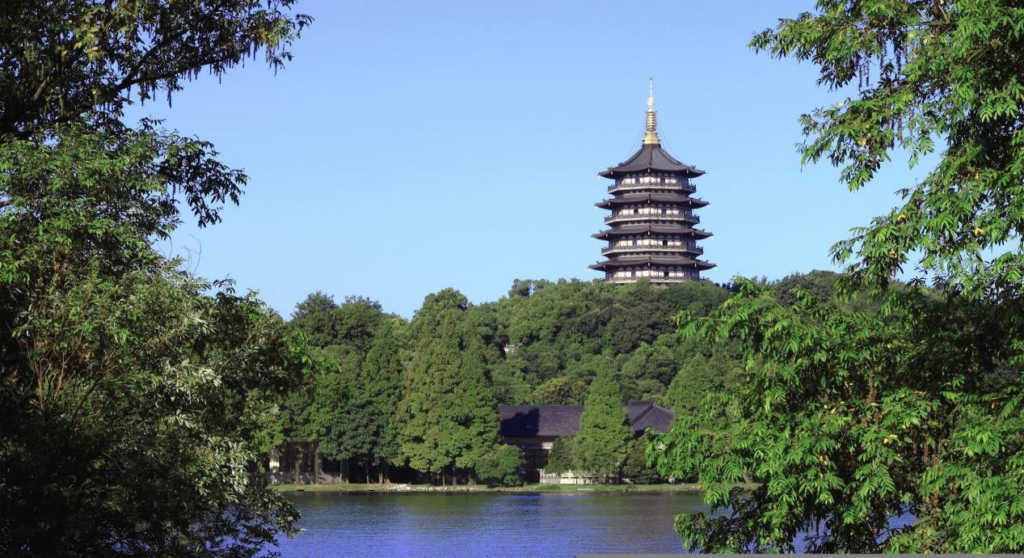
The West Lake and Leifeng Pagoda
West Lake, the emblematic gem of Hangzhou in Zhejiang, is celebrated as a paradise on earth. Its serene and captivating lake views, coupled with its rich cultural monuments, have consistently inspired poets and artists throughout history.
The lake is adorned with an array of causeways, bridges, pagodas, temples,
and pavilions, along with man-made island. These attractions offer a bewitching experience throughout the year, with each season presenting its own unique beauty.
During spring, capture the enchanting sunrise at the Su Causeway; in summer, witness the graceful dance of lotus flowers in a pond; in autumn, gaze upon the luminous full moon reflecting off the poetic waters; and in winter, take in the serene snowscape over the Broken Bridge at Bai Causeway.
A full day is sufficient to explore West Lake from various perspectives, whether on foot, by bicycle, or via a traditional boat ride, each offering a distinct vantage point of this enchanting landscape.
Recommended Tour Itinerary
Classical Gardens, Suzhou
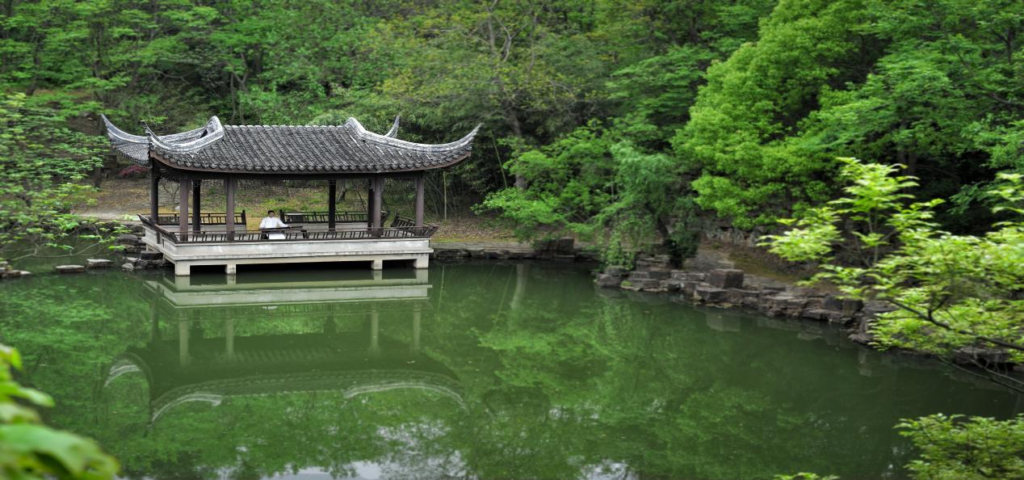
Classical Gardens,Suzhou
Gracefully situated in the northwestern part of Suzhou, the Classical Gardens have indisputably become emblematic of the city. Comprising nine such gardens, they form a harmonious ensemble of rocks, water, vegetation, and a variety of ancient architectural structures.
Among the most renowned are the Humble Administrator’s Garden, the Lingering Garden, the Master of the Nets Garden, and the Lion Grove Garden. These gardens are characterized by a distinctive type of window that frames a unique view from within a room, yet from the outside, it reveals a dramatically different vista composed of pavilions, bridges, terraces, fountains, rocks, flowers, and trees.
Visiting Suzhou’s gardens to admire their meandering waterways and exquisite scenes is a pleasure at any time of the year. However, for an added touch of beauty, mid-April to May is an ideal period to witness the blooming of plum and cherry blossoms within the gardens.
Each garden in Suzhou is conveniently located in close proximity to the others, accessible by a short stroll or a brief drive, making it feasible to experience the quintessence of all the gardens within a single day.
Recommended Tour Itinerary
Mingsha Mountain, Dunhuang

The MingSha Mountain
Nestled within the heart of the central Gobi Desert, Mingsha Mountain, also referred to as Echoing Sand Mountain and Crescent Lake, stands as an enchanting gem on the fringes of the verdant oasis town of Dunhuang.
This remarkable location is defined by its undulating sand dunes and a secluded, crescent-shaped natural lake. The dunes, averaging 100 meters in height, display a spectrum of colors—red, yellow, blue, white, and black—varying with the intensity of sunlight. The area is renowned for the extraordinary acoustic phenomenon where the shifting sands produce a multi-layered, orchestral echo, especially under the influence of light or strong winds, drawing many nature enthusiasts.
Embark on an unforgettable journey on camelback or motorcycle to follow in the footsteps of ancient Silk Road merchants, and immerse yourself in the tranquility and splendor of Crescent Lake, complemented by the surrounding Tang-dynasty style architecture amidst the dunes.
The optimal time for a one-night camping experience at the base of Mingsha Mountain, offering stunning views of the star-studded sky, sunsets, and sunrises, is from late April to mid-October. Alternatively, winter offers a majestic, snow-covered landscape. Located a mere 6 km from downtown Dunhuang, the central area of Dunhuang is also a must-visit if you have the opportunity, making it a convenient and rewarding detour.
Recommended Tour Itinerary
Plan A Trip for the customer to Discover to the Top attractions in China
China possesses an immense allure that captivates travelers with diverse interests from across the globe. No matter your preferences, these renowned and stunning locations consistently deliver an unforgettable experience. If you find yourself overwhelmed by the array of options, this guide is designed to assist you.
Should you seek further enchanting destinations within China, don’t hesitate to reach out to China Elephant Travel. We excel in crafting personalized travel plans to suit the unique needs of our clientele. Simply inform us of your desires and we will craft a bespoke journey for you that perfectly blends the splendor of nature with the depth of history.





